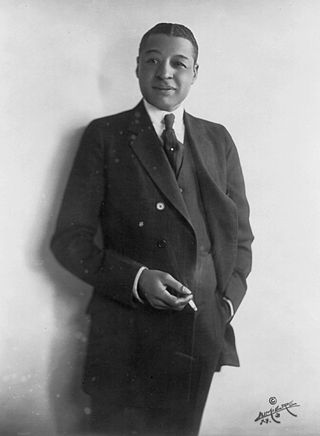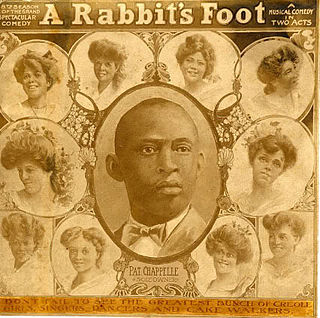
Bert Williams was a Bahamian-born American entertainer, one of the pre-eminent entertainers of the vaudeville era and one of the most popular comedians for all audiences of his time. While some sources have credited him as being the first Black man to have a leading role in a film with Darktown Jubilee in 1914, other sources have credited actor Sam Lucas with this same distinction for a different 1914 film, the World Film Company's Uncle Tom's Cabin. Ebony stated that "Darktown Follies was the first attempt of an independent film company to star a black actor in a movie", and credited the work as beginning a period in independent American cinema that explored "black themes" within works made for African-American audiences by independent producers.

Robert Allen Cole Jr. was an American composer, actor, and playwright who produced and directed stage shows. In collaboration with Billy Johnson, he wrote and produced A Trip to Coontown (1898), the first musical entirely created and owned by black showmen. The popular song La Hoola Boola (1898) was a result of their collaboration. Cole later partnered with brothers J. Rosamond Johnson, a pianist and singer, and James Weldon Johnson, a pianist, guitarist and lawyer, creating more than 200 songs.

John Rosamond Johnson was an American composer and singer during the Harlem Renaissance. Born in Jacksonville, Florida, he had much of his career in New York City. Johnson is noted as the composer of the tune for the hymn "Lift Every Voice and Sing". It was first performed live by 500 Black American students from the segregated Florida Baptist Academy, Jacksonville, Florida, in 1900. The song was published by Joseph W. Stern & Co., Manhattan, New York.
Theatre Owners Booking Association, or T.O.B.A., was the vaudeville circuit for African American performers in the 1920s. The theaters mostly had white owners, though about a third of them had Black owners, including the recently restored Morton Theater in Athens, Georgia, originally operated by "Pinky" Monroe Morton, and Douglass Theatre in Macon, Georgia owned and operated by Charles Henry Douglass. Theater owners booked jazz and blues musicians and singers, comedians, and other performers, including the classically trained, such as operatic soprano Sissieretta Jones, known as "The Black Patti", for black audiences.

In Dahomey: A Negro Musical Comedy is a landmark 1903 American musical comedy described by theatre historian Gerald Bordman as "the first full-length musical written and played by blacks to be performed at a major Broadway house." It features music by Will Marion Cook, book by Jesse A. Shipp, and lyrics by poet Paul Laurence Dunbar. It was written by Jesse A. Shipp as a satire on the American Colonization Society's back-to-Africa movement of the earlier nineteenth century.

African-American musical theater includes late 19th- and early 20th-century musical theater productions by African Americans in New York City and Chicago. Actors from troupes such as the Lafayette Players also crossed over into film. The Pekin Theatre in Chicago was a popular and influential venue.
"Nobody" is a popular song with music by Bert Williams and lyrics by Alex Rogers, published in 1905. The song was first publicly performed in February 1906, in the Broadway production Abyssinia. The show, which included live camels, premièred at the Majestic Theater and continued the string of hits for the vaudeville team of Williams and Walker.

George Walker was an American vaudevillian, actor, and producer. In 1893, in San Francisco, Walker at the age of 20 met Bert Williams, who was a year younger. The two young men became performing partners. Walker and Williams appeared in The Gold Bug (1895), Clorindy (1898), The Policy Player (1899), Sons of Ham (1900), In Dahomey (1903), Abyssinia (1906), and Bandanna Land (1907). Walker married dancer Ada Overton, who later also was a choreographer.

Aida Overton Walker, also billed as Ada Overton Walker and as "The Queen of the Cakewalk", was an American vaudeville performer, actress, singer, dancer, choreographer, and wife of vaudevillian George Walker. She appeared with her husband and his performing partner Bert Williams, and in groups such as Black Patti's Troubadours. She was also a solo dancer and choreographer for vaudeville shows such as Bob Cole, Joe Jordan, and J. Rosamond Johnson's The Red Moon (1908) and S. H. Dudley's His Honor the Barber (1911).

Lester Aglar Walton was a St. Louis-born Harlem Renaissance polymath and intellectual, a well-known figure in his day, who advanced civil rights in significant and prescient ways in journalism, entertainment, politics, diplomacy and elsewhere. The New York Times called him an "authority on Negro affairs." Historian Susan Curtis describes him as a man who "advised U.S. presidents and industrialists ... [and] was instrumental in desegregating housing" in New York City. As "America's first black reporter for a local daily," Walton also became the first full-time Black sportswriter and the first Black journalist to cover golf and the nascent sport of pre-1910 basketball.
The Ethiopian Art Theatre — originally called the Chicago Folk Theatre, later the Colored Folk Theatre, also referred to as The Ethiopian Art Players — was an African American theatre company based out of Chicago, Illinois. The company was an influential albeit short-lived (1922/1923–1925) group founded during the Harlem Renaissance. There are differing views over the precise year that the company was founded, 1922 or 1923. The founder was Raymond O'Neil, a white theatre director, and its principal sponsor was Mrs. Sherwood Anderson, also white; though all its performers were African American. The organization was unique and controversial during its era, primarily for being one of the few African American Theatre Companies to perform European theatrical works, but also, among other things, for producing theatrical works of African American playwrights for both African American and Non-African American audiences.

Anita Bush was an African American stage actress and playwright. She founded the Anita Bush All-Colored Dramatic Stock Company in 1915, a pioneering black repertory theatre company that helped gain her the moniker "The Little Mother of Colored Drama".

Negro Actors Guild of America(NAG) was formed in 1936 and began operation in 1937 to create better opportunities for black actors during a period in America where the country was at a crossroads regarding how its citizens of color would be depicted in film, television and the stage.

Black Vaudeville is a term that specifically describes Vaudeville-era African American entertainers and the milieus of dance, music, and theatrical performances they created. Spanning the years between the 1880s and early 1930s, these acts not only brought elements and influences unique to American black culture directly to African Americans but ultimately spread them beyond to both white American society and Europe.

Jesse Allison Shipp, Sr. was an American actor, playwright, and theatrical director, who is best remembered as a pioneer African-American writer of musical theater in the United States, and as the author of the book upon which the landmark play In Dahomey was based. Shipp played an influential role in expanding black theater beyond its minstrel show origins and is recalled as perhaps the first African-American director of a Broadway performance.

Irvin Colloden Miller was an American actor, playwright, and vaudeville show writer and producer. He was responsible for successful theater shows including Broadway Rastus (1921), Liza (1922), Dinah (1923), which introduced the wildly popular black bottom dance, and Desires of 1927 starring Adelaide Hall. For thirty years he directed the popular review, Brown Skin Models, influenced by the Ziegfeld Follies but exclusively using black performers. "In the 1920s and 1930s, he was arguably the most well-established and successful producer of black musical comedy."
Odessa Warren Grey was milliner, entrepreneur, and performer in Harlem, New York. She is best known as the star of the silent film, Lime Kiln Field Day (1913) where she co-stars with Bert Williams.

George Walker and Bert Williams were two of the most renowned figures of the minstrel era. However the two did not start their careers together. Walker was born in 1873 in Lawrence, Kansas. His onstage career began at an early age as he toured in black minstrel shows as a child. George Walker became a better known stage performer as he toured the country with a traveling group of minstrels. George Walker was a "dandy", a performer notorious for performing without makeup due to his dark skin. Most vaudeville actors were white at this time and often wore blackface. As Walker and his group traveled the country, Bert Williams was touring with his group, named Martin and Selig's Mastodon Minstrels. While performing with the Minstrels, African American song-and-dance man George Walker and Bert Williams met in San Francisco in 1893. George Walker married Ada Overton in 1899. Ada Overton Walker was known as one of the first professional African American choreographers. Prior to starring in performances with Walker and Williams, Overton wowed audiences across the country for her 1900 musical performance in the show Son of Ham. After falling ill during the tour of Bandana Land in 1909, George Walker returned to Lawrence, Kansas where he died on January 8, 1911. He was 38.
Lottie Gee(néeCharlotte O. Gee; 17 August 1886 Millboro, Virginia – 13 January 1973 Los Angeles) was an American entertainer who performed in shows and musicals during the Harlem Renaissance. She is perhaps best known as a performer in the 1921 Broadway hit, Shuffle Along, the show that launched the careers of Josephine Baker and Florence Mills.

Charlotte Louise Johnson, known as Lottie Williams and Lottie Thompson, was an American actress, singer, and dancer. A pioneering performer in African-American musical theater, she is best remembered for starring in several stage works with her second husband, Bert Williams, both on Broadway and in vaudeville. These included several musicals created by composer Will Marion Cook, lyricist Paul Laurence Dunbar, and the playwright Jesse A. Shipp; including Sons of Ham (1900), In Dahomey (1903), and Abyssinia (1906) among other works. In these musicals she portrayed mainly supporting character roles and was usually a featured singer and/or dancer. However, she portrayed the title role and the main protagonist in the Cook, Dunbar, and Shipp musical My Tom-Boy Girl (1905).
















